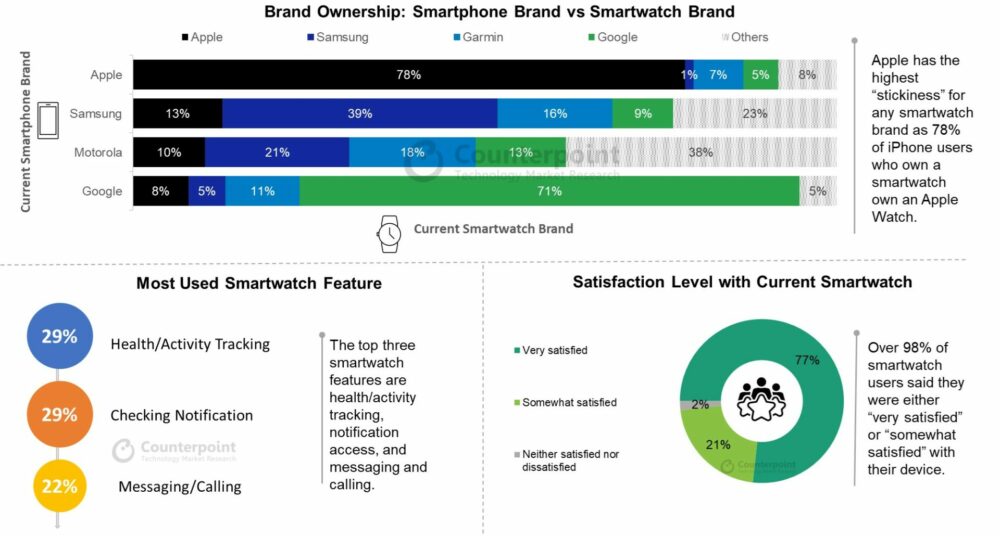Trends
Apple’s device ecosystem multiplies its brand strength and stickiness
Counterpoint’s most recent consumer survey shows that nearly 80% of smartwatch users who own an iPhone report that they own an Apple Watch. This was the highest share of any brand. Google Pixel users come in second with 71% of Pixel smartphone users who own a smartwatch saying that they own the Google Pixel Watch.
These findings help explain how Apple managed to achieve 56% share of the US smartwatch market in 2022 (according to Counterpoint’s US Smartwatch Tracker). Meanwhile, among Samsung smartphone users who own a smartwatch, only 40% use Samsung Galaxy Watches. Samsung’s struggle to get Galaxy smartphone users to adopt its smartwatches is also clear in Counterpoint’s sell-through data. According to Counterpoint’s Smartwatch Tracker and US Sell-Through by Channel Tracker, Apple sold about one Apple Watch for every three iPhones in Q4 2022, while Samsung sold only one Galaxy Watch for every ten Galaxy smartphones in the US.
Commenting on Apple’s success in the US smartwatch market, Research Analyst Matthew Orf said, “Our consumer research survey supports a general premise of ours – consumers generally purchase their devices as part of a broader ecosystem of devices and operating systems. Apple and iOS dominate the US smartphone market and iPhone users are more likely to adopt other Apple products due to their superior interoperability. With Apple’s smartphone installed base share surpassing 50%, it has a huge potential market to target with Apple Watches, while other smartwatch brands are stuck fighting for the rest of the pie. According to Apple Watch users, the most significant reason for selecting their current smartwatch was that they like the brand.”
US Smartwatch Consumer Survey-Key Insights

The top three smartwatch features according to respondents are health and activity tracking, notification access, and messaging and calling, with health and activity tracking being most popular among older users and notification checking being more popular among younger users. Popular health and activity tracking features include step counter, sleep tracker, heart rate monitor and blood oxygen monitor. Meanwhile, users are also using their smartwatches for connectivity – interacting with notifications from social media as well as messaging and calling friends, family and coworkers. When asked about their overall experience with their current smartwatch, more than 70% of the respondents using Apple, Samsung, Google and Garmin smartwatches reported being “very satisfied” with their device and 82% stated they wore their smartwatch every day.
Commenting on the high overall level of satisfaction among smartwatch users, Senior Analyst Arushi Chawla said, “It is interesting to note that smartwatch users are overwhelmingly satisfied with their devices. Despite Apple’s gargantuan lead in brand stickiness and its brand popularity, users of other smartwatch brands did not report a significantly lower level of satisfaction with their devices. Sometimes we hear from consumers who do not own a smartwatch that there are no strong use cases for smartwatches, and this hinders adoption. But according to our consumer study, smartwatch users are overwhelmingly satisfied with their devices, citing health and fitness tracking, as well as notification access, as central uses. This suggests that there is room to educate consumers on the benefits of smartwatches in everyday life and further drive the adoption of the form factor. OEMs and component players stand to gain if they can educate consumers on how smartwatches can benefit their daily lives.”
In addition to collecting insights into user satisfaction and smartwatch use, Counterpoint’s consumer survey also investigated how long users have owned their device as well as when they intend to purchase their next device. In total, 59% of respondents had purchased their smartwatch in the past year and only 14% had purchased their device more than two years ago. About 50% of the respondents stated they intended to purchase a new smartwatch within the next year, while only 16% said they intended to purchase their next smartwatch in over two years. This points to a holding period of just over two years for most users. Additionally, 77% of the respondents stated that Apple was the most preferred brand for their next smartwatch. The share of respondents willing to pay $500 or more for their next smartwatch was double the share of those who stated they spent $500 or more on their current smartwatch, suggesting rising ASPs for the segment.
CT Bureau













You must be logged in to post a comment Login